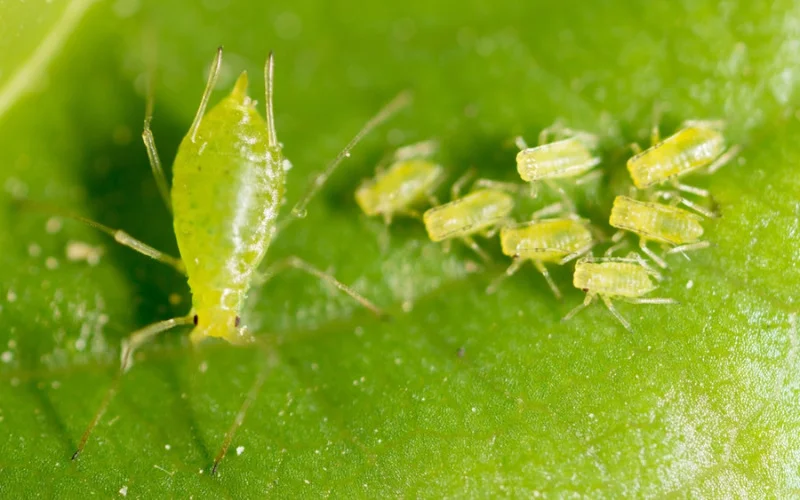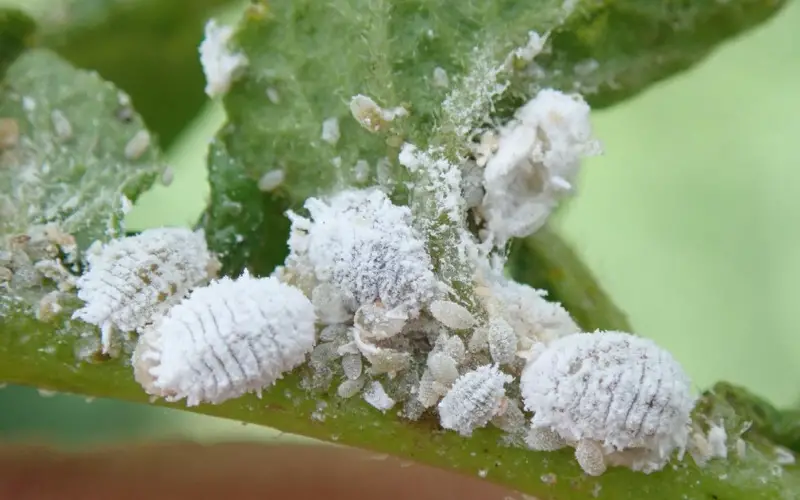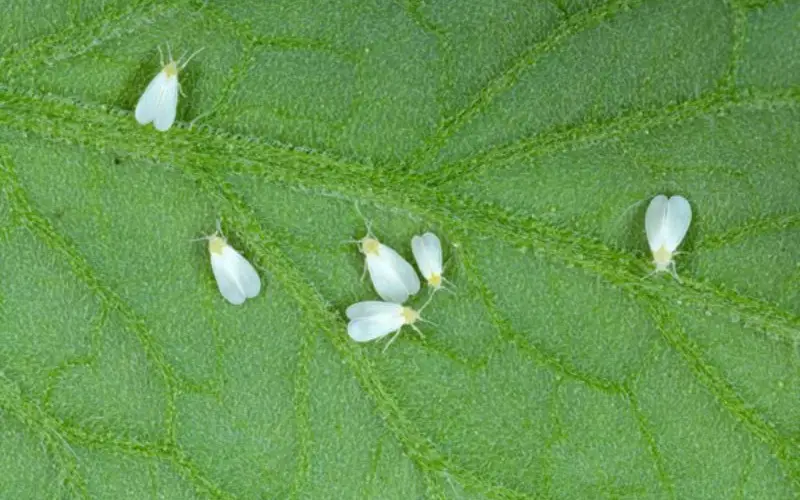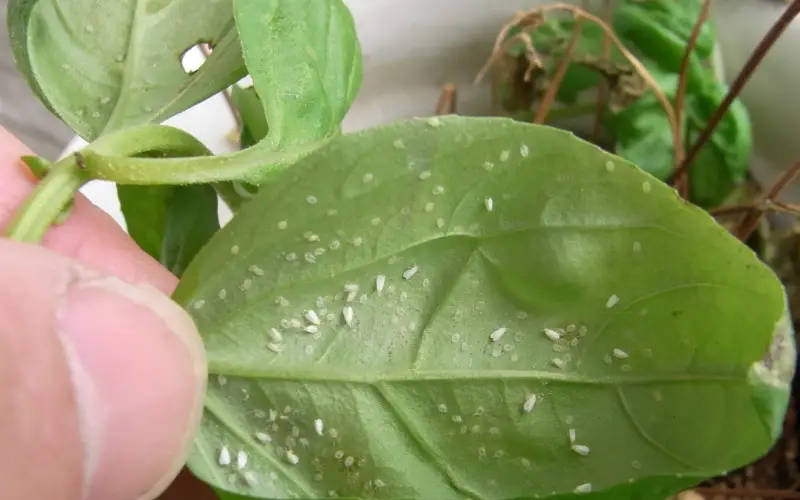Owning houseplants adds to the aesthetic of your home, and most of all, it can be refreshing in unique ways. But there are indeed some downsides when it comes to maintaining these plants.
Have you ever noticed some white bugs in your plants? If so, you are probably wondering how to get rid of these white bugs in your house plants, and fortunately, this article has provided every piece of information you need to know on this subject.
These white bugs may not be the same insect, but you will discover how to identify them soon and how to get rid of them for good.
The Tiny White Bugs In My Houseplants?
These tiny white bugs are different insects, and eliminating them will be easier if you identify what type of insect there are. Three major white bugs may appear in your houseplant: aphids, mealybugs, or whiteflies.
1. Aphids

The type of aphids that are found on house plants is called root aphids. They have a small, round, translucent body that a close and careful look can only see, and they leave behind a white chalky honeydew on the roots and stems ads they feed.
Root aphids will be present if your house plant is in a warm environment, and they cause damage to your plants that can be observed by stunted growth and yellowing of leaves, making the plants susceptible to diseases.
2. Mealybugs

Mealybugs can be identified by their wingless, oval, soft, segmented, and cotton-like appearance on the leaves of plants.
Their presence on your plants indicates that they feed on stems and leaves by their sucking mechanism. They pierce plant parts with stylets and draw the sap from the tissue.
If there are a few of these insects in your house plant, you can easily get rid of them, but if they appear in masses, you have to take rapid action before they cause severe damage.
3. Whiteflies

Whiteflies are similar to aphids and mealybugs as they are soft-bodied, but they have wings that can be used for flight, and they are triangular.
They mostly gather underneath leaves and will fly away if disturbed in the slightest; these bugs are more active during the day and will hardly be seen at night time. They will feed on common house plants with soft and smooth leaves.
Where Do These Bugs Come From?
When these bugs start to appear in your house plants, you start to wonder where they are from, and knowledge of this can allow you to prevent them from coming into your plant next time.
- They can come from new plants brought to the house
- Bad potting soil
- Flowers and vegetables brought to your garden
- Keeping your houseplants outside during summer
- Ants are lovers of the honeydew produced by some of these insects, so they can also bring them into your house plant
Symptoms of Their Effect
Leaving these bugs for too long on your houseplants can have a damaging effect on them. You may start to notice these effects when it’s too late, or you can recognize them from the start. Here are some of the symptoms that your houseplant has bugs lurking inside.
- You notice traces of sticky-like substances called honeydew which can be produced by both whiteflies and mealybugs
- Yellowing of leaves
- Delayed growth of plants and in severe cases, the plants don’t grow at all
- Drooping of branches
- Easily exposes plants to diseases and bacteria
Some of these symptoms are often confused with nutrient deficiency, but when you notice all of these signs, you have a dangerous bug attacking your house plants.
How To Get Rid Of Little White Bugs on Your Houseplants
There are various ways to get rid of these bugs, but you will need to be extra careful as you deal with the plants indoors and not outdoors.
Your best way to eliminate these bugs is to attack in the morning or early evening as they are not very active at night and the method of control you choose depends on your preference.
1. Hose Them off
This method is best for whiteflies and mealybugs as they dwell mostly on the leaves of your house plant. Be sure to carry out this method outdoors to prevent flooding your home.
You should also ensure that the water pressure is high to get rid of all the honeydew and any eggs on the leaves. Hosing should be done away from other plants to prevent them from transferring.
2. Yellow Sticky Trap
This method is the most convenient for your houseplants as it is easy to do. This method involves using yellow paper coated with adhesive.
Bugs that feed on leaves look at the color yellow as fresh new foliage to feed on, so they fall easily into this trap. If this sticky trap is unavailable, you can make your own by coating yellow paper with petroleum jelly.
After getting the bugs on this trip, you have to check for eggs on your plant and get rid of them, and this requires you to pair this method with another.
3. Use a Vacuum
You can use a vacuum to get rid of plants that have been covered in eggs. Set the vacuum to a low suction level and use it for the underside of the leaves to ensure that you have collected all the eggs completely. Follow his process for a few days, and afterward, empty the vacuum of all the eggs and keep them away from other plants.
4. Insecticide or Natural Control
Various insecticides have been manufactured to kill bugs like this. Spraying your plants with these chemicals morning and evening can help kill these bugs, and for this method to be effective, you need to do this for a few days, and it works best in the mornings and evenings.
If you prefer a home solution, you can use dish soap. Add 8 drops of dish soap into one liter of water and transfer into a spray bottle.
Because this mixture may not be accurate, test it on a random leaf and wait for 2 days. If the leaf you tested on burns, you need to dilute the mixture more.
You can test it out for a second time, and if it doesn’t burn the leaf, you can use it on your houseplant. Spray this mixture on the top and underside of the leaves and after a short time, wash the leaves to prevent the dish soap from attracting other insects. This method is not the fastest and will take a few weeks before full results can be seen.
You can also use a mixture of vinegar and water to kill the bugs, but don’t forget to test out the solution on random leaves first to ensure that it does not adversely affect your houseplants.
Neem oil is also known for killing these bugs; it is an essential oil that can be a preventive measure as well as a treatment.
You can use this directly on the soil, but if you want it to stick to the leaves, you can mix it with dish soap and water.
After this mixture has been on the leaves for some time, wash the dead bugs off and repeat this process for some days. Do not use neem oil under the sunlight as it traps heat and causes dehydration to your plant.
5. Natural Repellants
Bugs dislike plants with a strong smell, so keeping such plants close to your houseplants can help a lot. These plants include cilantro, mints, cloves, parsley, onions, hummingbirds bush, pineapple sage, and bee balm. If you do not want these plants in your house, you can keep some of their leaves in your houseplant instead.
How To Prevent These Bugs From Getting to Your House Plant
Prevention is always better than cure, and this case is no exception. Here are some preventive actions to take to avoid these bugs in general.
1. Check The Plants
If you are purchasing a new plant, before leaving the nursery, be sure to inspect the soil and leaves properly to detect any of these bugs.
This way, you have avoided the problem. Even after the purchase, you should continue to check these plants to kill any of these bugs immediately they appear.
3. Use Fertilizers With Less Nitrogen Content
Nitrogen may seem like a very good idea for your soil, but a fertilizer with a high content will do more harm than good to your plants. These fertilizers attract bugs that love rich soil instead use soils rich in organic contents.
Other preventive measures include
- Pruning
- Regular weeding
- Using a yellow sticky trap
- Neem oil
Conclusion
Houseplants add to your home aesthetic but have the opposite outcome if their leaves are wilted and there is no growth.
All these are the effect of those little white bugs you see around your houseplants; this article has covered all you need to know about these bugs, including identification and treatment.
You can get rid of these bugs by using insecticide, neem oil, this soap, pruning, natural repellants, a yellow sticky trap, a vacuum, and a hose. We have also listed some helpful preventive actions you can take to avoid this problem completely.
Helpful Links:
- Types Of Soil Mites
- Do Aphids Bites Or Stings
- How to Stop Ants Nesting in Plant Pots
- How to Get Rid of Ants in My Flower Pots Naturally
We trust this article helped you learn how to get rid of little white bugs in your house plants. You may also want to check out the Difference Between Soil Mites And Root Aphids.
Thanks for taking the time to read our article, and we hope you find it helpful. Would you mind leaving a comment below if you have any suggestions?
Kindly reach out to people by sharing this post on social media.
If you liked this article, then please follow us on Facebook, Instagram, and Pinterest.

